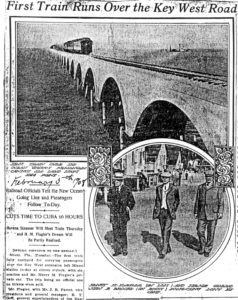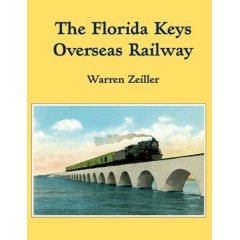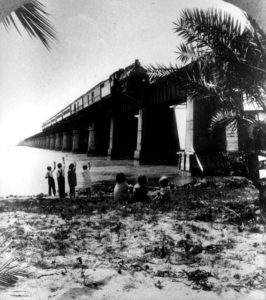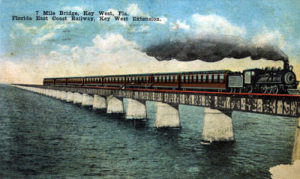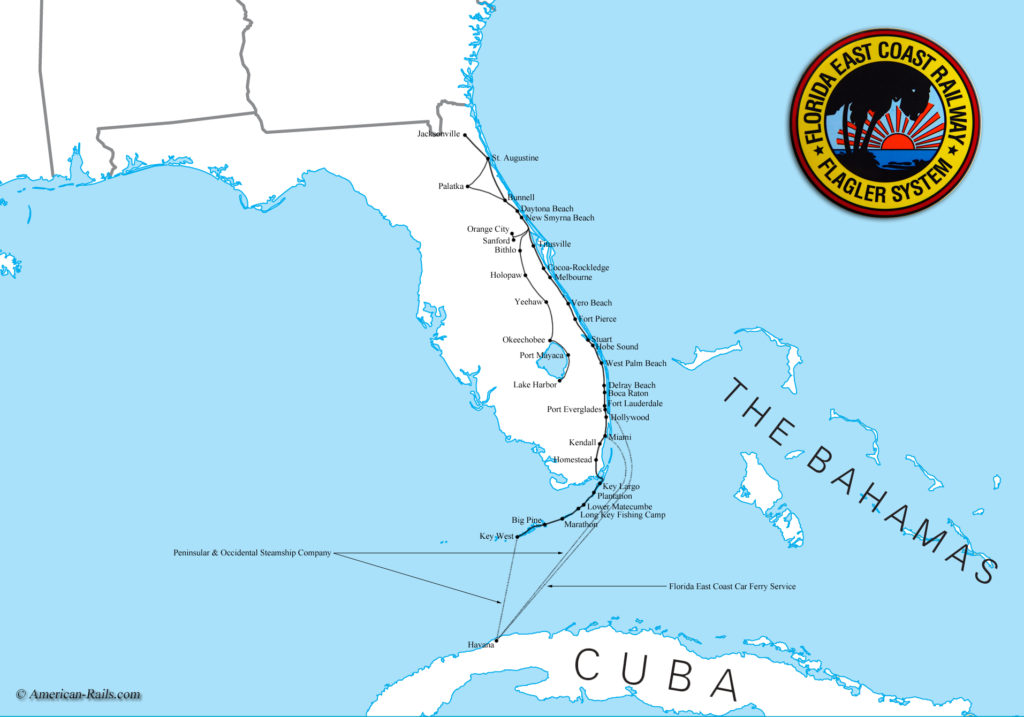Henry Morrison Flagler was a man of fragile aspect to his compliments 82 years had been the motor in the creation and development of the Standard Oil Company, the one that contributed the capital, the brain behind the bonanza of the oil business of the time and at the same time the person who did the most for the development of the young state of Florida. Flagler had the vision then to take the Railroad from the USA to Cuba with the same single ticket. Many called the project “Flagler’s Chimera” but people like Henry Flagler are the ones who turn dreams into reality.
At the beginning of the 20th century, the most important city in Florida was not Miami, nor San Agustin, nor Pensacola. Orlando, Fort Lauderdale and Jacksonville did not exist yet. The most important city in Florida was Key West, which was essentially a Cuban city with some influence from the United States and the Bahamas.
Flagler visited San Agustín in the mid-1880s, liked the city but considered that there were no hotels that offered adequate accommodation. In 1885 he returned to San Agustín and began the construction of the Ponce de León hotel with 540 rooms. Realizing that a good transportation system was needed to serve the hotels, Flagler bought several short rail lines that later formed the Florida East Coast Railway.
Originally Flagler planned that West Palm Beach was the terminal of its rail system, but in the years of 1894 and 1895 there were strong frosts in the area, causing that Flagler reconsidered its original plan. 100 Kilometers south in the hamlet that is today the city of Miami there had been no frosts. To convince Flagler to extend his railroad to Miami, several community owners offered parcels of land in exchange for extending their lines to Miami. Julia Tuttle, whom Flagler had met in Cleveland, had a trade at the mouth of the Miami River and was one of the local leaders who provided land for the endeavor.
Those incentives led to the creation of Miami which did not legally exist as a city at that time. The Florida East Coast Railroad arrived in Miami in 1896. Flagler channeled the city, built streets, developed the first municipal system of electricity and water. Flagler also financed the city’s first newspaper, The Metropolis.
Following its 1905 expansion policy, Flagler decided that his Florida East Coast Railway should extend from Miami to Key West. A distance of 206 kilometers.
At that time, the government of the United States was engaged in building the Panama Canal and Cayo Hueso was the deepwater port of the United States closest to the new canal. Flagler wanted to take advantage of receiving channel traffic and increase trade with Cuba. It should be noted that in 1905 the ties of Key West with Cuba were much stronger than those with the United States, which as we said was a Cuban city with American and Bahamian influence.
The complex investment required many engineering and construction innovations, tasks never attempted before were being undertaken. At one point in the construction, more than 4,000 workers participated in it. During the 7 years that the construction lasted, they had to face the scourge of three cyclones, one in 1906 that caused the death of more than 200 workers and others in 1909 and 1910.
Huge bridges were being built and moving lots of rocks, sand, earth and water with what we would now consider primitive machinery. Virtually all the equipment was moved by steam. Bilge pumps, winches, hammers to fit piles, concrete mixers and barges and boats were moved by steam. There were no hydraulic equipment.
The Miami-Cayo Hueso railway increased, as Flagler had supposed, the traffic of tourists from the north to the hotels of the Florida keys and the commerce that came from the Panama Canal but also tremendously developed the trade between Cuba and the United States via Key West. . The modern and efficient rail system of Cuba of the time was connected by ferry with the Flagler railway in Key West and from there with the railroad of the United States in the era of gold of the railroads.
These connections created one of the first international intermodal transport systems in the world and Cuba took advantage of the new logistics to become a major US supplier of products that it was not previously possible to supply. Cuba developed an important management of the export of pineapples that left the field and in less than two days they were in New York without leaving their containers.
The flow of passengers between Cuba and the United States increased as one could buy a train ticket Santiago de Cuba-New York and after making the train trip to Havana, took the ferry to Key West and from there by train to New York with the same ticket. It is true that one came to Manhatan, but remember that this was in 1912, the year that the Titanic capsized.
The Railroad on the Sea was partially destroyed by the cyclone of September 1935, a Category 5 hurricane that has been called by many “the cyclone of the century”. The traffic of passengers and cars from Cuba continued after the disappearance of the railroad to Key West until after 1959. Many people came to Miami for a few days with their car from Cuba and met American families who had their businesses in Miami and lived in Cuba , traveling every weekend to Cuba to be with his family.
Many of the original bridges were replaced in the 1980s and the road now goes over new bridges. Several of the old railway bridges can be seen from the road and are used to fish from them. They remain there as the mark and vision of a great man, the tenacity of a generation and our homage to Henry Flagler.
SUEÑO HECHO REALIDAD: VIAJE EN FERROCARRIL DESDE SANTIAGO DE CUBA A NEW YORK.
Henry Morrison Flagler era un hombre de aspecto frágil a sus cumplidos 82 años había sido el motor en la creación y desarrollo de la Standard Oil Company, el que aportó el capital, el cerebro detrás de la bonanza del negocio petrolero de la época y a su vez la persona que más hizo por el desarrollo del joven estado de La Florida. Flagler tuvo la vision entonces de llevar el Ferrocarril desde EEUU hasta Cuba con un solo pasaje. Muchos llamaron al proyecto “la Quimera de Flagler” pero personas como Henry Flagler son quienes convierten los sueños en realidad.
A principios del siglo XX la ciudad más importante de Florida no era Miami, ni San Agustín, ni Pensacola. Orlando, Fort Lauderdale y Jacksonville no existían aún. La ciudad más importante de la Florida era Cayo Hueso, que era esencialmente una ciudad cubana con alguna influencia de Estados Unidos y las Bahamas.
Flagler visitó San Agustín a mediados de la década de 1880, le gustó la ciudad pero consideró que no había hoteles que ofrecieran alojamiento adecuado. En 1885 regresó a San Agustín y comenzó la construcción del hotel Ponce de León con 540 habitaciones. Dándose cuenta que hacía falta buen sistema de transporte para servir a los hoteles, Flagler compró varias líneas cortas de ferrocarril que luego formaron el Florida East Coast Railway.
Originalmente Flagler planeaba que West Palm Beach fuera la terminal de su sistema ferroviario, pero en los años de 1894 y 1895 hubo fuertes heladas en el área, haciendo que Flagler reconsiderara su plan original. 100 Kilómetros al sur en el caserío que es hoy la ciudad de Miami no había habido heladas. Para convencer a Flagler de que extendiera su ferrocarril a Miami, varios propietarios de la comunidad le ofrecieron parcelas de tierra a cambio de que extendiera sus líneas hasta Miami. Julia Tuttle, a quien Flagler había conocido en Cleveland tenía un comercio en la boca del río Miami y fue una de los líderes locales que aportaron tierra para el empeño.
Esos incentivos llevaron a la creación de Miami la cual no existía legalmente como ciudad en esa época. El Florida East Coast Railroad llegó a Miami en 1896. Flagler canalizó la ciudad, construyó calles, desarrolló el primer sistema municipal de electricidad y agua. Flagler financió además el primer periódico de la ciudad, The Metropolis.
Siguiendo con su política de expansión 1905 Flagler decidió que su Florida East Coast Railway debía extenderse desde Miami a Cayo Hueso. Una distancia de 206 kilómetros.
En aquella época, el gobierno de Estados Unidos estaba enfrascado en construir el Canal de Panamá y Cayo Hueso era el puerto de aguas profundas de Estados Unidos más cercano al nuevo canal. Flagler quería aprovechar las ventajas de recibir el tráfico del canal y aumentar el comercio con Cuba. Hay que destacar que en 1905 los lazos de Cayo Hueso con Cuba eran mucho más fuertes que los que tenía con Estados Unidos, que como dijimos era una ciudad cubana con influencia norteamericana y bahamesa.
La compleja inversión requirió muchas innovaciones de ingeniería y construcción, se estaban emprendiendo tareas nunca antes intentadas. En un momento de la construcción más de 4,000 trabajadores participaron en la misma. Durante los 7 años que duró la construcción, tuvieron que afrontar el azote de tres ciclones, uno en 1906 que causó la muerte de más de 200 obreros y otros en 1909 y 1910.
Se estaban construyendo enormes puentes y moviendo cantidad de rocas, arena, tierra y agua con lo que ahora consideraríamos maquinaria primitiva. Prácticamente todo el equipo era movido por vapor. Bombas de achique, winches, martinetes para encajar pilotes, mezcladoras de concreto y las barcazas y embarcaciones eran movidas por vapor. No existían los equipos hidráulicos.
El ferrocarril Miami-Cayo Hueso incrementó, como Flagler había supuesto, el tráfico de turistas del norte hacia los hoteles de los cayos de Florida y el comercio que venía del Canal de Panamá pero además desarrolló tremendamente el comercio entre Cuba y Estados Unidos vía Cayo Hueso. El moderno y eficiente sistema ferroviario de Cuba de la época se conectaba vía trasbordador con el ferrocarril de Flagler en Cayo Hueso y de ahí con la red ferroviaria de Estados Unidos en la era de oro de los ferrocarriles.
Estas conexiones crearon uno de los primeros sistemas internacionales intermodal de transporte en el mundo y Cuba aprovechó la nueva logística para convertirse en un suplidor importante de Estados Unidos de productos que anteriormente no le era posible suministrar. Cuba desarrolló una importante gestión de la exportación de piñas que salían del campo y en menos de dos días estaban en Nueva York sin salir de sus contenedores.
El flujo de pasajeros entre Cuba y Estados Unidos se incrementó ya que uno podía comprar un billete de tren Santiago de Cuba-Nueva York y después de hacer el viaje en tren hasta La Habana, tomaba el trasbordador a Cayo Hueso y de ahí en tren hasta Nueva York con el mismo billete. Es verdad que uno llegaba molido a Manhatan, pero recuerden que esto era en 1912, el año que zozobró el Titanic.
El Ferrocarril sobre el Mar fue parcialmente destruido por el ciclón de septiembre de 1935, un huracán con categoría 5 que ha sido llamado por muchos “el ciclón del siglo”. El tráfico de pasajeros y automóviles desde Cuba siguió después de la desaparición del ferrocarril a Cayo Hueso hasta después de 1959. Muchas personas venían a Miami por unos días con su automóvil desde Cuba y conocí familias norteamericanas que tenían sus negocios en Miami y vivían en Cuba, viajando cada fin de semana a Cuba para estar con su familia.
Muchos de los puentes originales fueron reemplazados en los años 80 y la carretera va ahora sobre nuevos puentes. Varios de los viejos puentes del ferrocarril se pueden ver desde la carretera y se usan para pescar desde ellos. Quedan ahí como la huella y visión de un gran hombre, el tesón de una generación y nuestro homenaje a Henry Flagler.
Agencies/MemoriasCubanas/Carlos Rodríguez/Excerpts/ Internet Photos/ Arnoldo Varona/ TheCubanHistory.com
THE CUBAN HISTORY, HOLLYWOOD.




